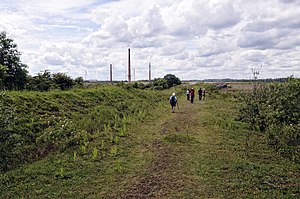Difference between revisions of "Fen Causeway"
(Created page with ''''The Fen Causeway''' or the '''Fen Road''' is the modern name for a Roman road which runs between Denver, Norfolk in the east and Peterborough in Northamptonshire t…') |
|||
| Line 1: | Line 1: | ||
| − | ''' | + | [[File:Roman Road (Fen Causeway), Whittlesey geograph 3279634 by Julian-Dowse.jpg|right|thumb|300px|The Fen Causeway west of Whittlesey]] |
| + | {{county|Cambridgeshire}} | ||
| + | Thee '''Fen Causeway''' or the '''Fen Road''' is the modern name for a short [[Roman road]] in the [[Great Fen]], which runs between [[Denver]] in [[Norfolk]] in the east and [[Peterborough]] in [[Northamptonshire]] in the west.<ref>Codrington, T., ''Roman Roads in Britain'' (1903).</ref><ref>Phillips, C.W. ''The Fenland in Roman Times''. Royal Geographical Society (1970).</ref> For much of its course, this is not a straight road such as we associate with the Romans but has to respect the reality of the fenland marsh. | ||
| − | The | + | The course of the road is 24 miles long, through three counties. With its western end approximately at [[Peterborough]] at the edge of [[Northamptonshire]]. It runs east across [[Flag Fen]] in [[Cambridgeshire]] and crosses the modern course of the [[River Nene]] to run through the north of [[Whittlesey]]. Eastward of here the course is obscured, but it has been traced to the hamlet of [[Eldernell]] and across the [[Twenty Foot River]] and turning southeast to [[Westry, Cambridgeshire|Westry]] and the north edge of [[March, Cambridgeshire|March]]. |
| − | + | Eastward of March, the route crosses the River Nene Old Course and enters [[Norfolk]] north of [[Christchurch, Cambridgeshire|Christchurch]]. | |
| + | In Norfolk, the Fen Causeway passes south of [[Nordelph]] and on to [[Denver]]. The [[Old Bedford River]] and [[New Bedford River]] slice through obscuring its course near Denver Sluice, but the Fen Causeway appears to form the lane along which the village of Denver stretches. | ||
| + | |||
| + | ==Connections== | ||
| + | At its western end it is possible that the road or an extension of it met the major Roman north-south route, [[Ermine Street]], west of modern-day [[Peterborough]]. Thus there would have been a link from the [[Midlands]] to the eastern lands beyond the fen. | ||
| + | |||
| + | In the east, it is possible that the route continued east of Denver to meet [[Peddars Way]] at [[Castle Acre]], but the evidence for this is less certain. | ||
| + | |||
| + | ==Form== | ||
The road is thought to have been raised above the marshy fens using gravel, with a width of up to 60 feet. Towards its western end it is close to the Bronze Age route across [[Flag Fen]]. At that archaeological site, which is open to visitors, a section through the Roman Road can be seen. | The road is thought to have been raised above the marshy fens using gravel, with a width of up to 60 feet. Towards its western end it is close to the Bronze Age route across [[Flag Fen]]. At that archaeological site, which is open to visitors, a section through the Roman Road can be seen. | ||
| Line 12: | Line 22: | ||
{{coord |52|34|N|0|4|E|type:landmark_region:GB_dim:39000|display=title}} | {{coord |52|34|N|0|4|E|type:landmark_region:GB_dim:39000|display=title}} | ||
| − | |||
[[Category:Roman roads]] | [[Category:Roman roads]] | ||
Latest revision as of 21:45, 28 October 2014
Thee Fen Causeway or the Fen Road is the modern name for a short Roman road in the Great Fen, which runs between Denver in Norfolk in the east and Peterborough in Northamptonshire in the west.[1][2] For much of its course, this is not a straight road such as we associate with the Romans but has to respect the reality of the fenland marsh.
The course of the road is 24 miles long, through three counties. With its western end approximately at Peterborough at the edge of Northamptonshire. It runs east across Flag Fen in Cambridgeshire and crosses the modern course of the River Nene to run through the north of Whittlesey. Eastward of here the course is obscured, but it has been traced to the hamlet of Eldernell and across the Twenty Foot River and turning southeast to Westry and the north edge of March.
Eastward of March, the route crosses the River Nene Old Course and enters Norfolk north of Christchurch.
In Norfolk, the Fen Causeway passes south of Nordelph and on to Denver. The Old Bedford River and New Bedford River slice through obscuring its course near Denver Sluice, but the Fen Causeway appears to form the lane along which the village of Denver stretches.
Connections
At its western end it is possible that the road or an extension of it met the major Roman north-south route, Ermine Street, west of modern-day Peterborough. Thus there would have been a link from the Midlands to the eastern lands beyond the fen.
In the east, it is possible that the route continued east of Denver to meet Peddars Way at Castle Acre, but the evidence for this is less certain.
Form
The road is thought to have been raised above the marshy fens using gravel, with a width of up to 60 feet. Towards its western end it is close to the Bronze Age route across Flag Fen. At that archaeological site, which is open to visitors, a section through the Roman Road can be seen.
References
Coordinates: 52°34′N 0°4′E / 52.567°N 0.067°E
